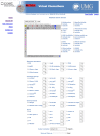The Mu.Ta.Lig. Chemotheca: A Community-Populated Molecular Database for Multi-Target Ligands Identification and Compound-Repurposing
- PMID: 29725591
- PMCID: PMC5917039
- DOI: 10.3389/fchem.2018.00130
The Mu.Ta.Lig. Chemotheca: A Community-Populated Molecular Database for Multi-Target Ligands Identification and Compound-Repurposing
Abstract
For every lead compound developed in medicinal chemistry research, numerous other inactive or less active candidates are synthetized/isolated and tested. The majority of these compounds will not be selected for further development due to a sub-optimal pharmacological profile. However, some poorly active or even inactive compounds could live a second life if tested against other targets. Thus, new therapeutic opportunities could emerge and synergistic activities could be identified and exploited for existing compounds by sharing information between researchers who are working on different targets. The Mu.Ta.Lig (Multi-Target Ligand) Chemotheca database aims to offer such opportunities by facilitating information exchange among researchers worldwide. After a preliminary registration, users can (a) virtually upload structures and activity data for their compounds with corresponding, and eventually known activity data, and (b) search for other available compounds uploaded by the users community. Each piece of information about given compounds is owned by the user who initially uploaded it and multiple ownership is possible (this occurs if different users uploaded the same compounds or information pertaining to the same compounds). A web-based graphical user interface has been developed to assist compound uploading, compounds searching and data retrieval. Physico-chemical and ADME properties as well as substructure-based PAINS evaluations are computed on the fly for each uploaded compound. Samples of compounds that match a set of search criteria and additional data on these compounds could be requested directly from their owners with no mediation by the Mu.Ta.Lig Chemotheca team. Guest access provides a simplified search interface to retrieve only basic information such as compound IDs and related 2D or 3D chemical structures. Moreover, some compounds can be hidden to Guest users according to an owner's decision. In contrast, registered users have full access to all of the Chemotheca data including the permission to upload new compounds and/or update experimental/theoretical data (e.g., activities against new targets tested) related to already stored compounds. In order to facilitate scientific collaborations, all available data are connected to the corresponding owner's email address (available for registered users only). The Chemotheca web site is accessible at http://chemotheca.unicz.it.
Keywords: LAMP server; Pybel; drug repurposing; molecular database; molecular descriptors; multi-target drugs; openbabel; scientific collaboration.
Figures
References
LinkOut - more resources
Full Text Sources
Other Literature Sources
Research Materials




